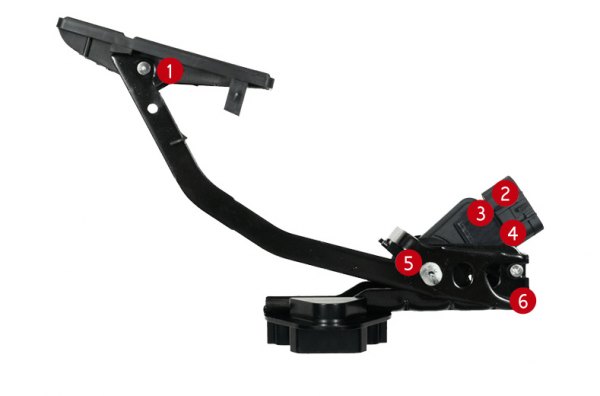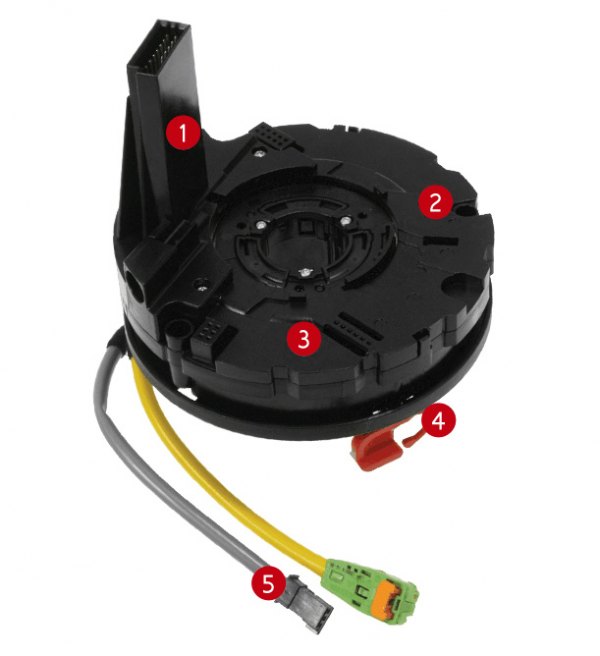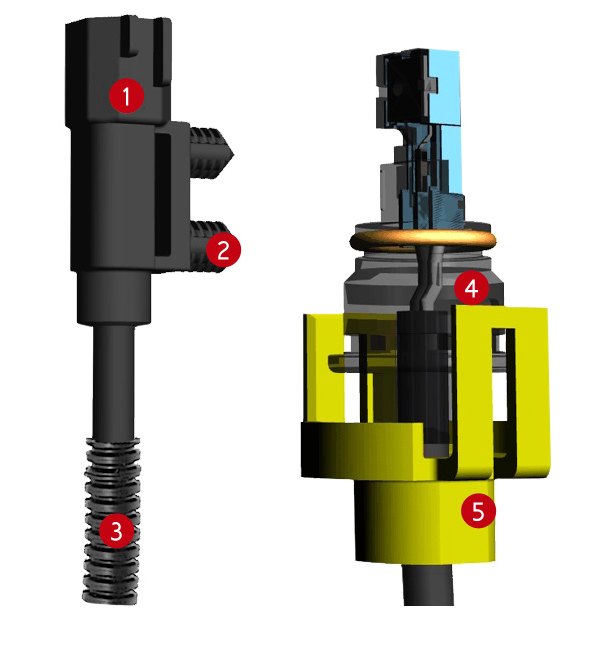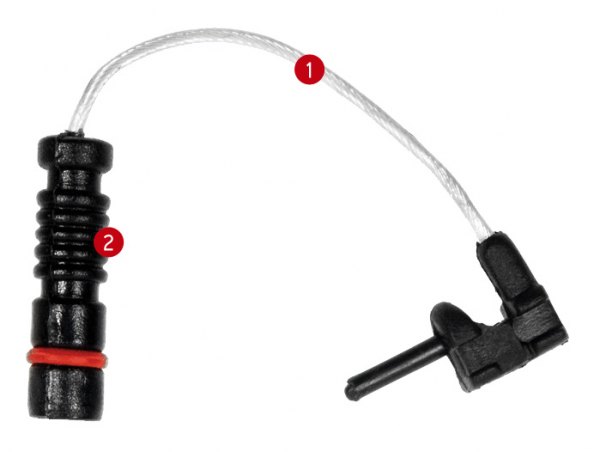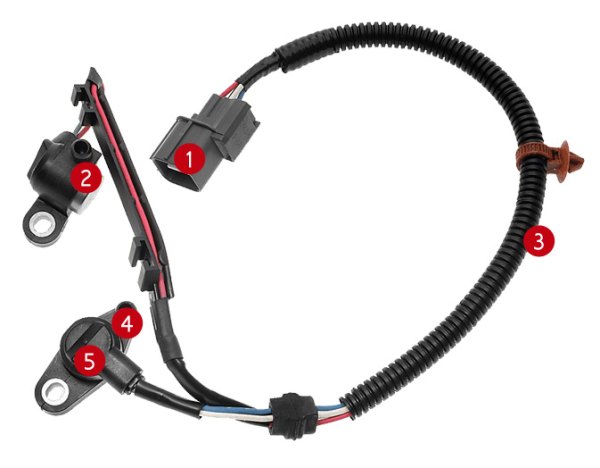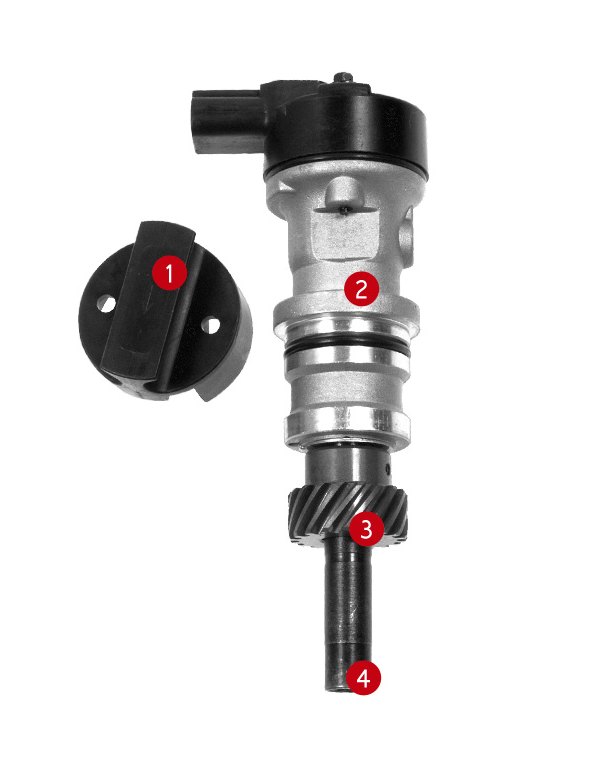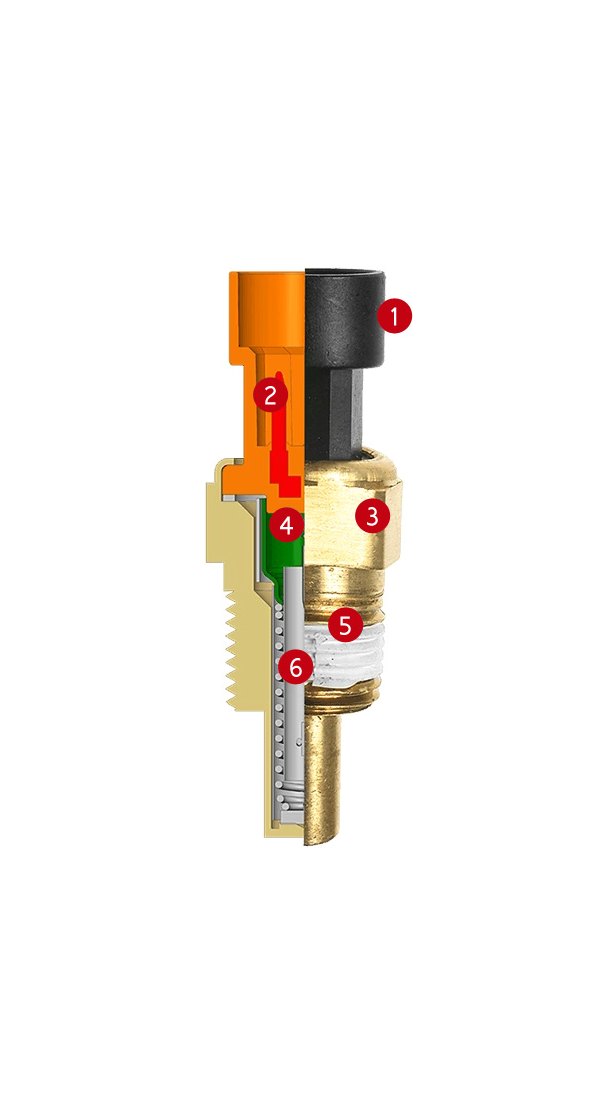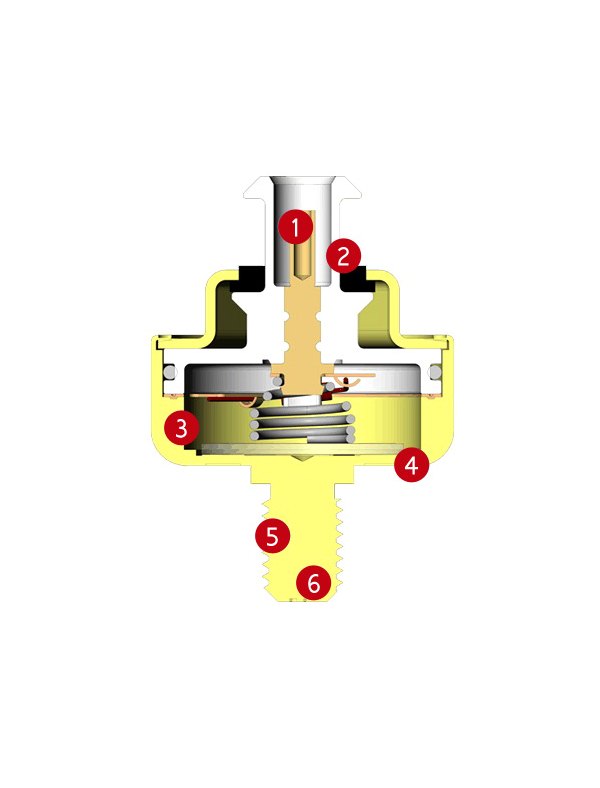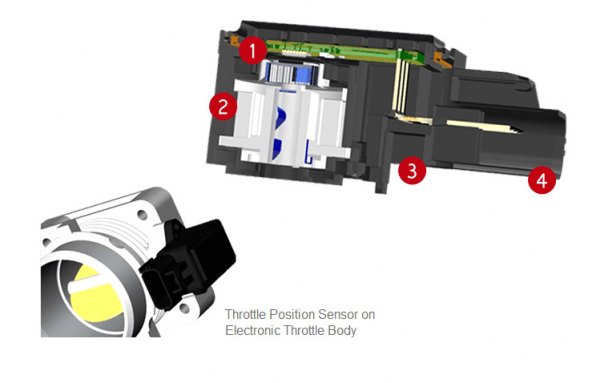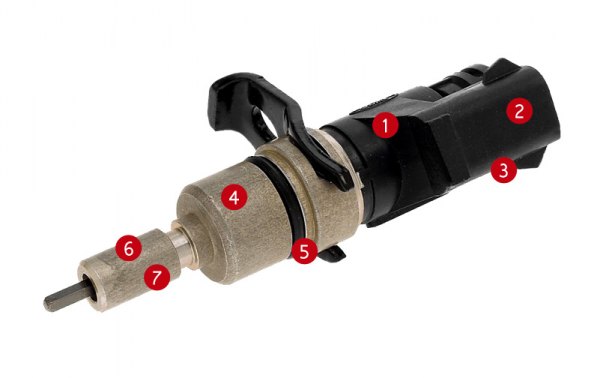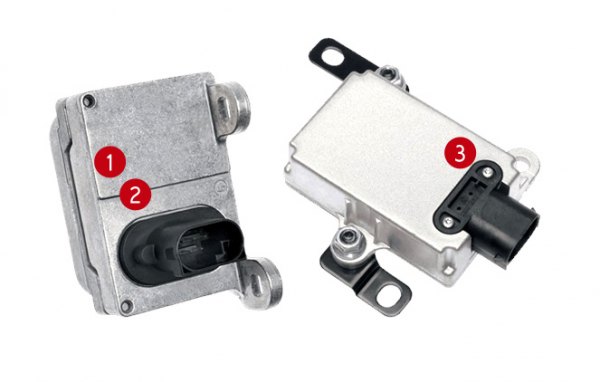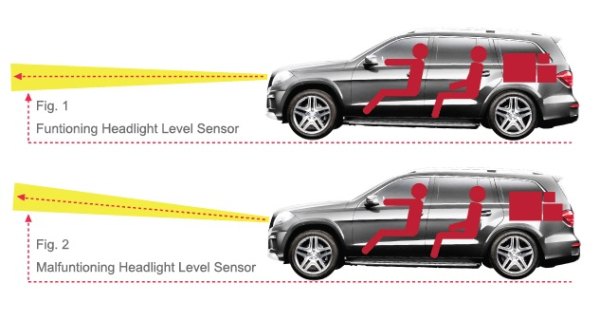
Products Information
- Sensors
- Switches/Relays
- Fuel Injection
- Emission
- Ignition Coils
- Electrical
- Ignition Wires
- TPMS
- Air Fuel Delivery
- Overview
-
The expansive Standard sensor line is your go-to source for the form, fit and function demanded by today’s technicians. All state-of-the-art sensors are designed to meet or exceed OE specifications and to deliver exceptional performance and extended service life. Standard offers a broad array of sensor coverage including: air charge/manifold temperature, accelerator pedal, barometric pressure, camshaft, coolant temperature, crankshaft, fuel vent, knock, manifold absolute pressure, mass air flow, throttle position, vehicle speed, yaw rate, ride height, taillight, pedal stroke, headlamp leveling, air quality, battery current, rain, sun load, door pinch, brake fluid, fuel level, and many more.
“You want coverage? You’ve got it. And a whole lot more."
- Accelerator Pedal Sensors
-
The accelerator pedal sensor assembly combines the familiar accelerator pedal with a dual output sensor for a drive-by-wire application. The ubiquitous throttle cable is replaced by a pedal position sensor to continuously measure driver input.
Features:
- High-impact ABS plastic provides the best solution to pedal support and spring guide components
- Pedal sensor assemblies are 100% tested for output versus pedal position. The slope and linearity of the two separate outputs are accurately checked to ensure correct operation on the vehicle
- High strength nylon provides the best solution to pedal support and spring guide components
- The multi-finger wiper design accurately controls sensor contact to within a few grams of force
- Dual return springs provide redundancy and a comfortable, familiar pedal force profile
- Several polymers are used in the construction of the assembly to provide the best combination of strength and support for the spring guide components
- Air Charge/Manifold Temperature Sensors
-
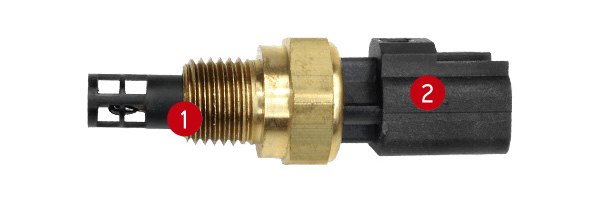
The air charge/manifold temperature sensor is used by the computer to measure air density for fuel mixture control. The computer uses this information to trim the air/fuel ratio according to the air density.
Features:
- 100% factory tested to ensure trouble-free performance
- Sensor design specifies tight tolerance thermistor response values to assure accuracy of the temperature measurement and proper part operation
- Airbag Clock Springs
-
The airbag clock spring is an assembly that contains a spirally wound flat ribbon to allow the steering wheel to be turned while maintaining a constant electrical connection to the driver airbag, horn and other electrical steering wheel mounted controls.
Features:
- A defective or failing airbag clockspring will not affect engine operation but will trigger the SRS light indicating compromised vehicle safety
- Manufactured from the finest materials and to the highest standards, producing a quality product with an extended service life
- Meet or exceeds the OE for fit, form, and function delivering a flawless install and precision performance
- Clockspring removal should be done by a professional and only after the battery has been disconnected followed by a timed electrical system discharge
- Complete coverage for import and domestic vehicles with over 100 sensors
- Anti-lock Brake (ABS) Sensors
-
The anti-lock braking system uses an ABS or wheel sensor to monitor the wheel speed and send this information to the ABS computer. The ABS computer uses this information to prevent the brakes from locking during a stop. Standard ABS sensor line has complete coverage for domestic and import applications with over 1900 ABS numbers cataloged – and growing.
Features:
- OE connectors and terminals are used to ensure accurate, water-tight connection to the engine wire harness
- Grommets and wire clips are included on the harness to ensure proper mounting and routing within the car chassis
- Sensor housing is made from high-quality glass reinforced plastic resin with both high temperature and environmental protection resistance
- Wire harness comes with protective sleeve to prevent wires from chafing and creating short circuits
- Sensors are 100% tested for proper functioning
What makes Standard ABS sensors the finest products.
ABS Sensors - Fast Facts
- The ABS sensor is typically located in each wheel hub/rotor on a four channel ABS system. Some rear wheel drive applications have the sensor mounted in the rear differential
- Generally these sensors will fail as a result of clogging from metallic debris, brake dust or dirt due to exposure to the harsh elements
- A failing sensor can illuminate the MIL or ABS warning lamp, and may cause failure of the anti-lock braking system to operate safely and properly
- An ABS sensor can be visually inspected and the wire winding and sensor harness can be tested for opens, shorts and proper factory-specified resistance with an ohmmeter
Testing
Standard left no stone unturned; performing extensive laboratory and real life testing that included measuring and comparing shaft speed vs. delta voltage, output voltage and variation to OE, magnetic field strength, air gap, output wave form, pulse width as well as a complete physical product comparison to OE.
Competition ABS Sensors
- No consistency in signal output performance.
- Inferior materials in the magnetic circuit which results in low voltage output and can lead to ABS system failure.
- No consistency in critical sensor dimensions which establish the gap between the sensor tip and target wheel which can lead to the sensor tip hitting the spinning target wheel causing sensor damage.
- Inadequate quality inspection and product testing.
- No consistency in matching OE for form, fit and critical function.
Standard vs Competition
Standard: ABS sensor# ALS1333 (GM 02-95; ranked in top 10 sellers) matches OE for output voltage, resistance, trigger wheel gap and all critical fit, form, and function measurables.
Competition: 29%-51% lower voltage output when compared to OE leading to potential ABS system failure. Incorrect mounting bracket does not match OE.
Standard: ABS Sensor# ALS198 (Ford 09-95; ranked in top 10 sellers) matches OE for output voltage, resistance, trigger wheel gap and all critical fit, form, and function measurables.
Competition: 45%-74% lower voltage output when compared to OE leading to potential ABS system failure. Inconsistent winding resistance, electrical inductance and magnetic field orientation resulting in poor sensor performance. Inconsistent gap between sensor tip and trigger wheel leading to potential sensor tip damage.
- Brake Pad Wear Sensors
-
The brake pad wear sensor or brake wear indicator is an added safety feature on many vehicles used to warn drivers if their brake pad’s thickness becomes too low and their useful life is short. Brake pad wear sensors are designed to “fail” as brake pads wear. They should be changed whenever the pads are replaced or when the vehicle’s warning light indicates. Intermotor offers a broad product offering for brake pad wear sensors.
Features:
- More than 100 SKUs cover over 2,500 direct applications
- Brake pad wear sensors are direct OE replacements with perfect fit, finish and function for flawless operation
- Camshaft/Crankshaft Position Sensors
-
The camshaft sensor determines which cylinder is firing to establish injector synchronization and coil firing sequence in DIS systems. Crankshaft sensors set ignition timing, supply the RPM signal, and determine engine speed. Standard engineering, manufacturing and testing excellence make Standard sensors the finest in the business, hands down.
Features:
- End-of-line testing for timing, pulse width and signal amplitude ensure consistent product performance
- Integrated A/D converter and digital signal processing with a dynamically adaptive switch point improves accuracy and operation
- Wire harness comes with protective sleeve to prevent wires from chafing and creating short circuits
- Custom magnetic circuit programming calibrates the sensor while performance testing for improved timing accuracy between the target wheel and sensor output
- Advanced circuitry protects the system from stray electromagnetic fields and power spikes
- Camshaft Synchronizer Assemblies
-
The camshaft synchronizer assembly consists of a camshaft position sensor mounted on an oil pump intermediate shaft. The synchronizer is driven off the camshaft and sends the camshaft rotational position information to the Powertrain Control Module (PCM) to establish injector synchronization and coil firing sequence in DIS systems.
Features:
- Includes a synchro positioning tool to ensure that the fuel and ignition systems stay in tune with the engine
- Complete assembly includes a camshaft synchronizer and camshaft position sensor for an easy, fast installation
- Brand new assemblies (not reman) match the original for fit, form and function, ensuring proper operation and performance
- 100% environmental, endurance and life cycle laboratory testing for timing, pulse width, and signal amplitude ensures consistent performance
- Coolant Temperature Sensors
-
The coolant temperature sensor changes resistance with the temperature. The coolant temperature sensor is critical to many PCM functions such as fuel injection, ignition timing, variable valve timing, and transmission shifting.
Features:
- 100% factory tested proper resistance value at specified temperature
- Primary thermistor wire leads are resistance-welded to connector terminals to ensure a reliable electrical connection in an environment of high vibration and changing temperature
- Precision machined brass housing to maximize thermal conductivity between sensor body and coolant
- Glass fiber reinforced plastic polymer connector insures excellent dimensional stability and proper mating connector fit over a wide range of temperature extremes
- Housing has tapered pipe threads for a tight fit in the mounting location
- Grease is applied inside brass housing to facilitate heat transfer with thermistors
- Knock (Detonation) Sensors
-
Knock sensors create a voltage signal based on the vibrations caused by detonation. The computer uses this signal to retard timing when spark knock occurs.
Features:
- An automated data acquisition system continuously monitors sensor output to ensure it responds with appropriate voltage at the specified frequency rate
- Primary thermistor wire allows resistance welded to connector terminals to ensure a reliable electrical connection in an environment of high vibration and changing temperature
- The sensor body is precision machined to tune the resonant frequency to the engine knock frequency
- The piezoelectric disc is the heart of the sensor. It is a sintered ferroelectric ceramic disc precision ground to tight physical tolerance
- All units are 100% tested using an accelerometer vibration test to ensure trouble-free operation
- Designed to respond to knock frequencies up to 1000Hz and shifts in engine knock frequency, making the engine more effective over a broad range of vehicle conditions
- MAP (Manifold Absolute Pressure) Sensors
-
The MAP sensor converts engine vacuum/manifold pressure to an electrical signal so the computer knows how much load the engine is under. This data is the basis for fuel delivery and timing control.
Features:
- Precise automated wire bonding equipment and inspection processes ensuring repeatable and reliable electrical connections
- 100% tested prior to shipping for sensor output voltage vs. pressure and response function
- The case is high temperature glass reinforced plastic and is designed to create a hermetically sealed cavity for the sensor on one side with the port for pressure on the other
- 100% tested during the manufacturing process for electronic component assembly and connectivity
- Throttle Position Sensors
-
The throttle position sensor moves with the throttle and sends a voltage signal to the computer indicating throttle angle and speed of movement data. The computer uses this data to measure engine load, adjust timing, fuel delivery, EGR, converter clutch operation and clear flood mode.
Features:
- The integrated circuit (IC) is capable of measuring the rotation of a small magnet attached to the throttle shaft and is calibrated to provide accurate, linear output characteristics
- Automated test equipment is used to calibrate and electronically lock output voltage accuracy, linearity and slope versus throttle angle
- The sensor is sealed from the under hood environment by a custom, elastomeric seal that provides an effective barrier from dust, vapor and liquids found under the hood
- The magnet is molded into a high performance polymer to ensure consistent location and low friction with the bearing surfaces
- Vehicle Speed Sensors
-
The vehicle speed sensor or VSS measures transmission/transaxle output or wheel speed. The ECM uses this information to modify engine functions such as ignition timing, air/fuel ratio, transmission shift points, as well as to initiate diagnostic routines.
Features:
- Stainless steel drive
- Internal bearing promotes trouble free operation and provides stable air gap between trigger element and sensor
- Output signal match to OE
- Silicone connector seal retains flexibility and preventes moisture intrusion
- Measures transmission/transaxle output or wheel speed and uses this information to modify engine functions such as ignition timing, AF ratio and transmission shift points
- Fluorosilicone seal for excellent sealing over a wide variety of temperature conditions
- 100% end-of-line testing for signal waveform ensures consistent product reliability and performance
- Yaw Rate Sensors
-
A yaw rate sensor (or rotational speed sensor) measures a vehicle’s angular velocity about its vertical axis in degrees or radians per second in order to determine the orientation of the vehicle as it threatens to roll over. By comparing the vehicle’s actual yaw rate to the target yaw rate, the on-board computer can identify to what degree the vehicle may be under- or over-steering, and what corrective action, if any, is required. Corrective action may include reducing engine power as well as applying the brake on one or more wheels to realign the vehicle. The yaw rate sensor is a key component in a vehicle’s stability control or electronic stability control system designed to provide motorists with increased safety, security, and control even in the most difficult driving conditions. Standard leads the way, delivering these high-quality, high-technology sensors.
Features:
- Wide measuring range for effective sensor operation
- 1 Mbaud/s CAN-signal output for precise performance
- Robust product design delivers dependable service life
TechSmart Sensors
- Intro
-
The automotive market today includes over 40 vehicle makes, over 400 models and countless variations of those models. Vehicle manufacturers continue to expand electronic componentry as well as the vast array of products needed to service these systems. These additional category opportunities have led to the development of TechSmart.
TechSmart is an exciting new brand of enhanced engine control products developed for the professional service technician. TechSmart was designed to help the technician with new technology, new categories, and problem-solving improvements to the original with a proven quality they can trust.
TechSmart encompasses Standard innovation, engineering expertise, superior product quality, meticulous testing, unmatched customer service, competitive pricing, and brand integrity. The qualities that have made Standard the engine management industry leader for more than 90 years, are at the heart of every TechSmart part.
- Air Bag
-
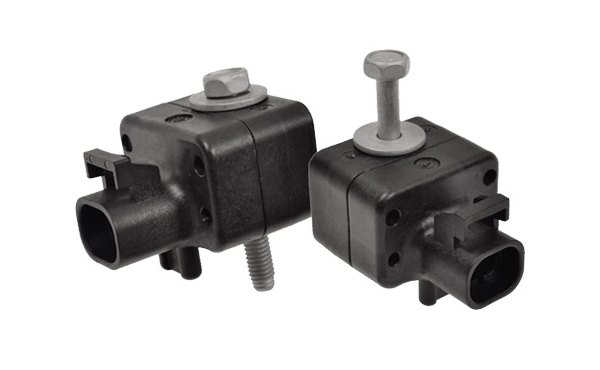
TechSmart air bag or impact sensors are used to signal a vehicle's air bag in the event of a frontal collision. The airbag sensor is an accelerometer, which is a small integrated circuit with integrated micro-mechanical elements. The microscopic mechanical element moves in response to rapid deceleration, and this motion causes a change in capacitance, which is detected by the electronics on the chip that then sends a signal to fire the airbag. Replacing a worn or failed OE sensor with a TechSmart air bag sensor provides a high-quality, yet inexpensive solution for drivers to remain safe.
- Air Quality
-
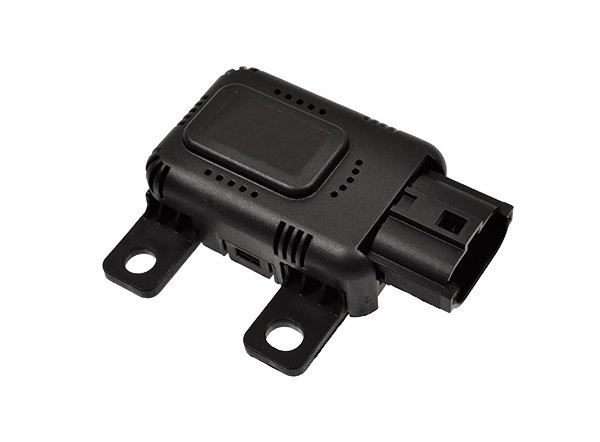
The HVAC control module monitors the outside air quality while in AUTO mode using the air quality sensor. There are 2 sensors inside the air quality sensor assembly. A hydro-carbon (HC) sensor that is used for detecting gasoline exhaust fumes and a Nox sensor that is used for detecting nitrous oxide or diesel exhaust fumes. When air quality around the front of the vehicle is poor, the air quality sensor system will send a signal to the HVAC system to begin operation. TechSmart offers the aftermarket's best premium air quality sensors, ensuring that when a TechSmart sensor is installed it means problem solved!
- Ambient Light
-

An ambient light sensor is used to measure the amount of light outside the vehicle. It then modifies the operation of automatic headlamps, daytime running lamps, and on some makes, it will adjust the climate control unit as it can also function as a sun load sensor. When the ambient light sensor fails, vehicle’s headlamps may not illuminate even when the outside light dips below the required threshold; and the automatic temperature control will not adapt to changing conditions.
- Automatic Headlight
-
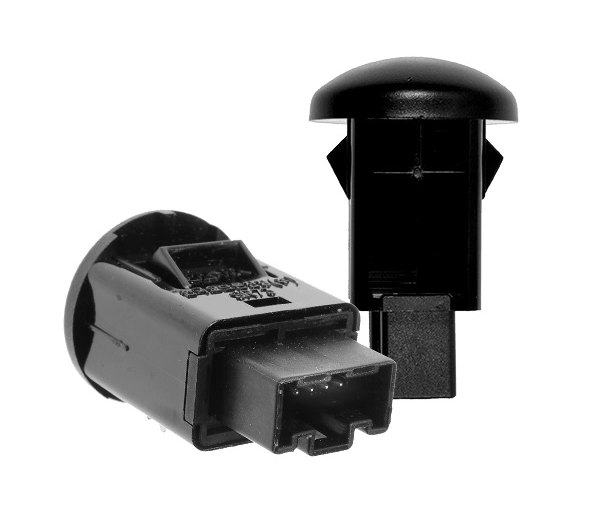
TechSmart delivers a line of proven-quality automatic headlight sensors. Automatic headlights eliminate the need for the driver to manually switch the headlights on or off. They are activated using a photoelectric sensor that senses lighting conditions at dawn or dusk. When the lighting conditions become too low, the automatic headlight sensors turn the lights on, increasing visibility for the driver. Trust TechSmart for a proven-quality solution when replacing this important safety feature.
- Battery Current
-
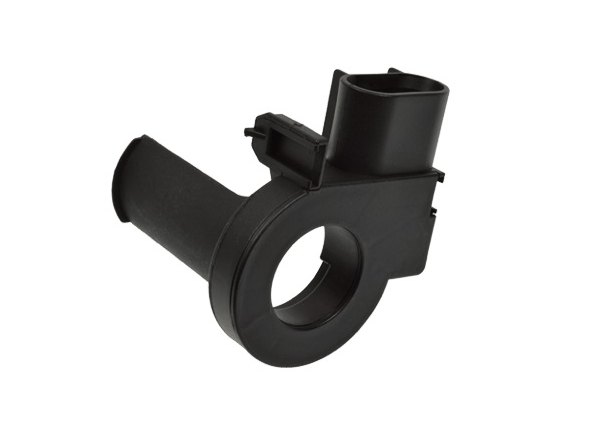
The battery current sensor is a fuel saving component connected to the negative battery cable. This sensor monitors battery current and will shut off the alternator when it detects full charge. This helps to prevent the alternator from overcharging the battery; increasing battery life and increasing MPGs by decreasing parasitic loss from the alternator. When the battery current sensor fails, the alternator will continue to run and overcharge the battery while decreasing MPG and battery life or the alternator will not know how to kick back on at full charge, which will lead to a drained battery. Replace a failed battery current sensor with a high-quality direct replacement TechSmart unit.
- Brake Booster Vacuum
-
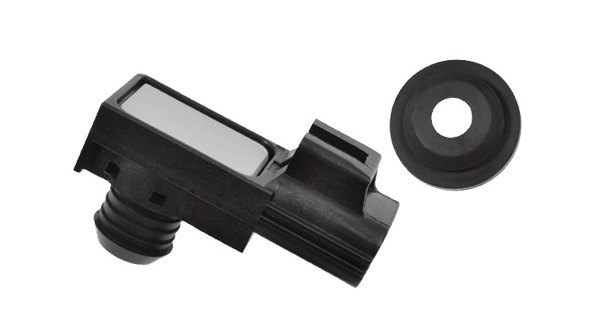
The brake booster vacuum sensor senses the amount of vacuum needed to maintain proper power brake operations. If the sensor reads a low vacuum situation, it will illuminate the check engine light and give a trouble code. These can often fail when contaminated brake fluid damages the sensor; creating a potentially dangerous situation on this critical safety component. The TechSmart brake booster vacuum sensors are high-quality replacements for damaged OE sensors that will ensure that the brake system is properly monitored.
- Fuel Level
-
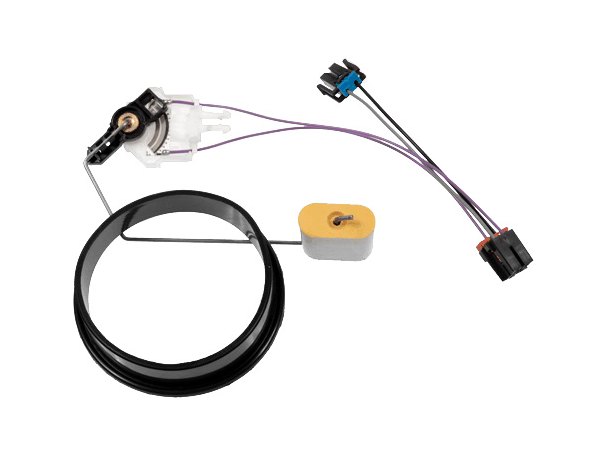
The automotive market today includes over 40 vehicle makes, over 400 models and countless variations of those models. Vehicle manufacturers continue to expand electronic componentry as well as the vast array of products needed to service these systems. These additional category opportunities have led to the development of TechSmart.
- Headlight Level
-
TechSmart offers a line of premium headlight level sensors that work with a vehicle's self-leveling headlight system adjusting the headlight height in relation to the vehicle height. If the vehicle's trunk is loaded and the rear is sagging, the vehicle’s lights may shine high. Functioning headlight level sensors adjust to compensate for the rear being low. When the OE sensor fails, headlights will either shine too high or too low, creating a potentially dangerous driving situation for you and other drivers. Trust TechSmart to provide the highest-quality replacement solution for a failed headlight level sensor.
- Humidity
-
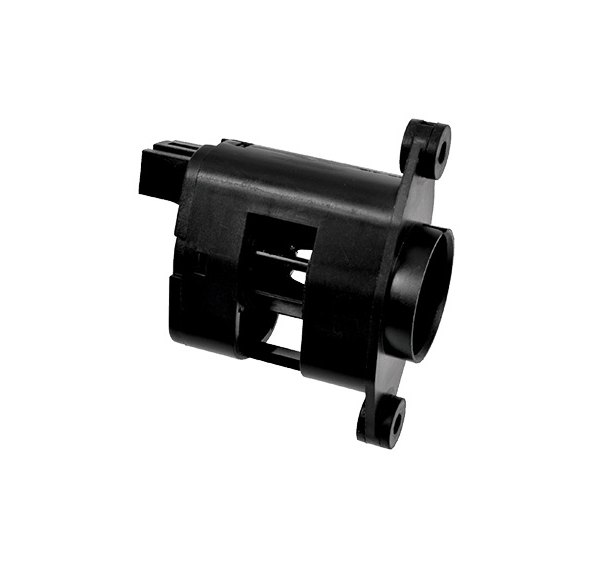
TechSmart offers a line of humidity sensors for late model import applications. Humidity sensors work with the vehicle's HVAC system to sense the humidity levels in the cabin and send a signal to the automatic climate control to begin operation. Always replace a failed humidity sensor with a premium TechSmart sensor to maintain comfort and proper HVAC operation.
- Oil Level
-
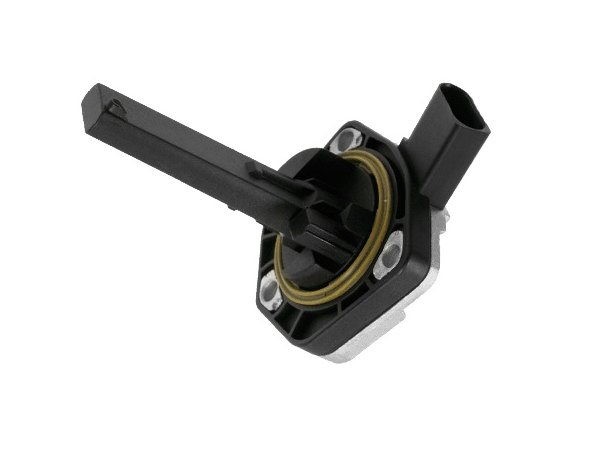
Oil level was once measured by a dipstick and a rag. Today’s technicians now work with digital oil level sensors that monitor a vehicle’s fluid level. The OE oil level sensor is prone to failure. When it malfunctions it illuminates the low oil warning light and may cause a bit of motorist anxiety. TechSmart has developed this new-technology, replacement oil level sensor for accurate, ‘better than OE’ performance.
- Park Assist
-
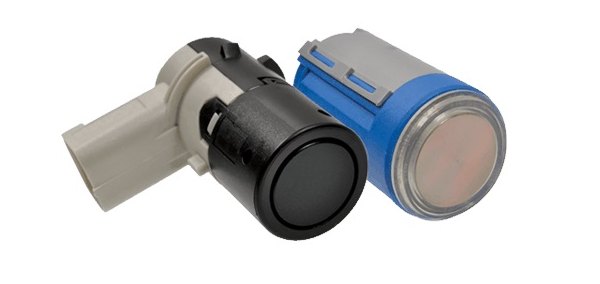
TechSmart offers a line of OE-specific premium park assist sensors, also known as back-up sensors. TechSmart park assist sensors are 100% matched to the OE body style. Each park assist sensor is guaranteed to fit and perform just like the original. Each TechSmart sensor connector is molded into the body just like the OE. Count on TechSmart to provide proven-quality solutions for these key safety elements.
- Rain
-

TechSmart also offers a line of premium-quality rain sensors. Automotive rain sensors measure the amount of light being reflected and sent back to the sensor. If the glass is wet, less light makes it back and the sensor sends a signal to the wipers to operate. This eliminates the need to constantly adjust the wipers for misty or intermittent rain situations. With a new rain sensor from TechSmart, you will keep your wipers operating efficiently and safely for the long haul.
- Sunload
-

Adding to TechSmart’s growing line of advanced technology sensors come sunload sensors. The sunload sensor works with the HVAC temp sensor located in the passenger compartment. If the sensor detects a high sunlight condition, it will signal the fan to come on at a higher-than-normal level to maintain in-cabin temperatures. Keep comfortable with premium-quality TechSmart sunload sensors.
- Transmission Oil Temperature
-
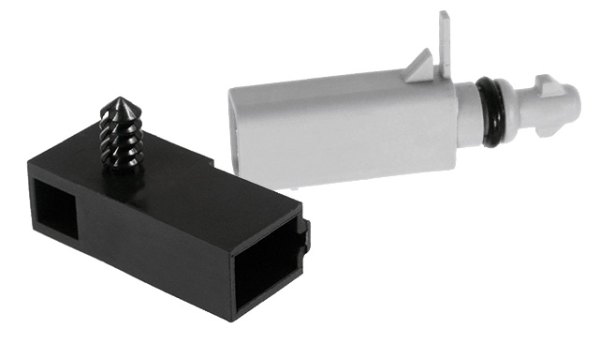
When an OE transmission oil temperature sensor fails, it can affect drivability, transmission service life, and comfort. Often the motorist will complain that the transmission is making a loud noise, the vehicle shifts hard, and the transmission will not shift into overdrive mode. The TechSmart transmission oil temperature sensor provides the technician with a high-quality, cost-effective, direct replacement for the failed OE part.
- Turbocharger Speed
-
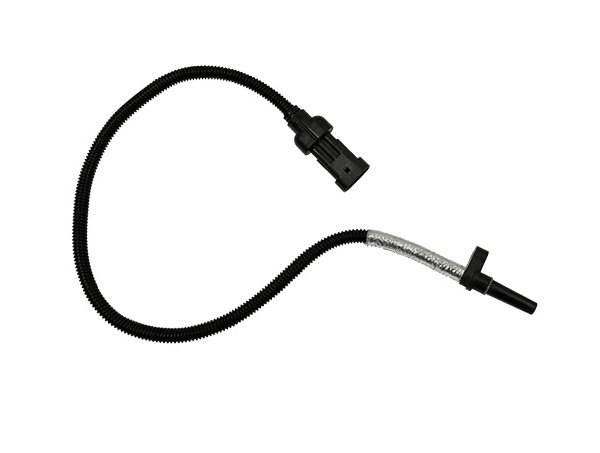
If your Ram 5.9L or 6.7L Cummins powered truck gets a P0106 code or exhibits excessive exhaust smoke and higher exhaust gas temperatures than normal, it may be the turbocharger speed sensor causing the problem. The ECM interprets the signal from the vehicle's turbocharger speed sensor to monitor operating speed and determine if the turbo is functioning properly. If the sensor fails and the turbo falls out of normal operating spec, this could result in a very costly turbocharger replacement. Replace a failed turbocharger speed sensor with a high-quality direct replacement TechSmart unit and prevent unnecessary repair bills.
- Overview
-
As the automotive industry continues to introduce more electronic systems, switches and relays will play a greater role in daily operation and repairs. With over 10,000 engine, multifunction, and driver operated switches and relays for import and domestic vehicles, Standard sets the bar for coverage you can count on. Standard switches and relays are all meticulously designed, manufactured and tested to meet or exceed OE specs, for impressive reliability and performance.
Standard is ready with a vast selection of technologically advanced components to address the daily operation and repair needs of technicians working on late model and older vehicles. The expansive line of the company includes: coolant fan, combination, cruise control, dimmer, door, hall effect, A/C cut-off, door jamb, idle, stoplight, variable valve timing oil pressure, door lock position, torque converter lock-up, transmission oil pressure, fog light, headlight, heated seat, ignition, parking brake, power door lock, power mirror, power seat, power window, rear defogger, temperature control, trunk release, turn signal and windshield wiper, just to name a few.
- Driver/Passenger Operated Switches
-
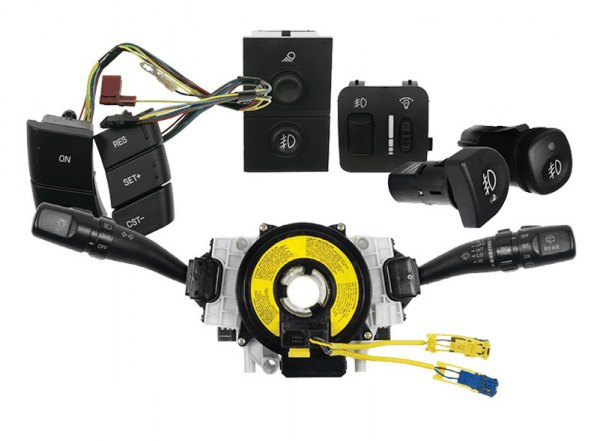
Standard offers a complete line of driver/passenger operated switches in addition to its engine switch offering. With more than 5,000 driver operated switches, Standard is sure to have your switch! Its expansive line of driver operated switches includes: combination, cruise control, dimmer, fog light, hall effect, headlight, heated seat, ignition, parking brake, power door lock, power mirror, power seat, power window, rear defogger, temperature control, trunk release, turn signal and windshield wiper, multi-function power seat memory, steering wheel audio control, hazard warning, and many more.
- Ignition Switches/Lock Assemblies
-

Decades of industry-leading research and development focused on meeting the technician’s needs for quality ignition switches has led Standard to offer a complete line of ignition switches and lock assemblies unsurpassed in quality. All Standard ignition switches, locks, and assemblies perfectly match the original for precision installation. Standard ignition lock assemblies feature a professional quality construction made using solid brass tumblers, chrome plated brass keys, die-cast zinc lock cores and multiple, randomly assigned key codes to always ensure superior operation.
- Relays
-
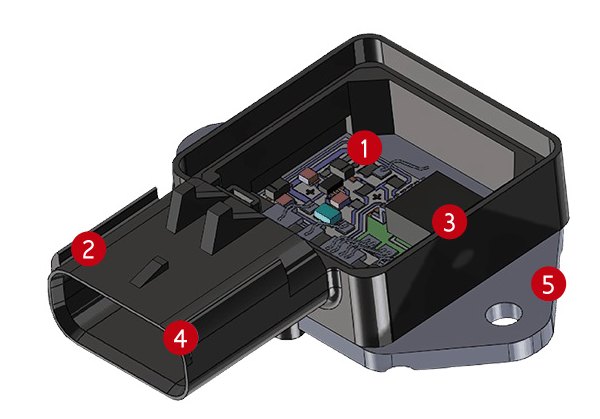
Standard is your go-to source for a full line of accessory and electronic relay solutions that support all key engine components and systems, including: Air Conditioner System, Alarm System, Battery Saver, Blower Motor, Compressor Cut-off, Delay Switch, EFI System, Electronic Engine Control, Fuel Pump, Headlight, Power Trim System, Turn Signal, Fuel Injection, Starter, Main, Power Window, Theft Deterrent, Coolant Fan, Horn, Fog Lamp, Diesel Glow Plug, Windshield Wiper, Sunroof, Rear Window Defogger, and many others. Standard offers more than 255 unique relay categories and coverage for all domestic and import applications. Standard relays match the OE for fit, form, and function to match what you take off the vehicle.
Features:
- Circuitry is designed to withstand electrical over-stress conditions such as reverse polarity, ESD transients, and jump start voltage extremes
- 100% tested during manufacturing for electronic component assembly and wire bond connectivity
- 100% tested prior to use for continuous current load, quiescent current, voltage drop, pull-in current, voltage, and hysteresis
- Copper terminals with aluminum inlay keep electrical resistance low and still provide benefits for wire bonding and corrosion protection
- Heatsink is made from aluminum for excellent corrosion resistance and thermal conductivity
- TechSmart Key Fobs
-
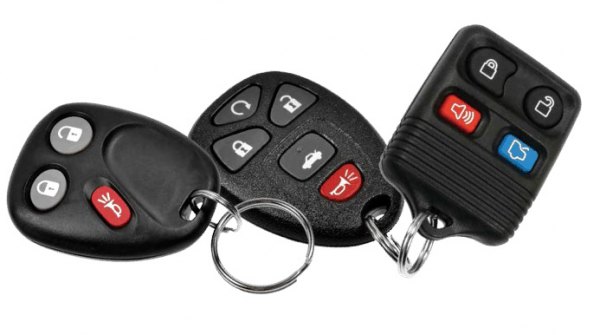
Most modern vehicles come with the option for a keyless entry, also known as a “Key Fob.” The problem is that these transmitters can drop, break, or get lost; rubber buttons can wear; contacts inside become corroded; and the plastic cause crack. TechSmart offers a complete line of keyless entry transmitters providing a high-quality, cost-effective solution to replace the damaged or lost original. Remember to always follow OE reprogramming instructions to ensure that your TechSmart keyless entry transmitter works in harmony with your vehicle.
- Overview
-

Vehicle performance and drivability are enhanced when a fuel injector delivers up to spec, and Standard fuel injection components do just that. For quality and coverage, Standard is your aftermarket leader for fuel injection and fuel systems.
Standard offers full coverage for import and domestic vehicles, with an unsurpassed range of premium, quality fuel injectors and fuel system components that meet or exceed OE. Standard fuel injectors are built in its TS 16949 certified OE manufacturing plant, where they undergo extensive testing to ensure precision quality, enhanced performance, and improved durability.
“For the coverage and quality you demand, make Standard your first and only choice.”
- Fuel Injectors
-
The fuel injector is an electronically controlled valve that is supplied with pressurized fuel by the fuel pump and when energized atomizes the fuel into a fine mist so that it can burn easily in the vehicle’s engine. Designed to match flow rates, spray patterns and body styles.

Features:
- OE matched injectors promote smooth engine operation reducing overall fuel consumption and harmful emissions
- High-temp Viton O-rings enable prolonged sealing of injector under extreme heat conditions
- Stainless steel calibration slide and spring assembly prevents corrosion within the fuel control body leading to an extended service life
- Precision wound and trimmed solenoid windings allow the computer to command efficient delivery of fuel
- High-temp Viton O-rings enable prolonged sealing of injector under extreme heat conditions
Standard Advanced Technology Solutions
Standard designs and manufactures a broad variety of fuel injector styles with matching flow rates, spray patterns and body styles including the disc, pintle and G injector configurations.

- Fuel and Water Separator Sensors
-
Fuel/water separator sensors monitor the vehicle’s diesel fuel for the presence of water, triggering the vehicle’s warning light to illuminate when it senses water is present. Standard offers a full line of fuel water sensors. Since fuel/water separator sensor can be easily damaged during a routine fuel filter replacement, this sensor is a high-failure high-replacement part. The Standard fuel water separator sensor line includes 12 sensors for Chevrolet/GMC Truck, Dodge, Sprinter, Jeep, and Ford truck.
“All Standard fuel/water separator sensors meet or exceed OE specifications for flawless performance and extended service life.”

- Overview
-
Standard gives you more emission control system support than any brand in the industry. A complete product offering means complete coverage for all of your emission control needs. And that coverage comes with peace of mind: as a basic manufacturer, Standard controls the process from start to finish, so you can always count on perfect performance, time after time.
“A complete product offering means complete coverage.”
- EGR Valves
-
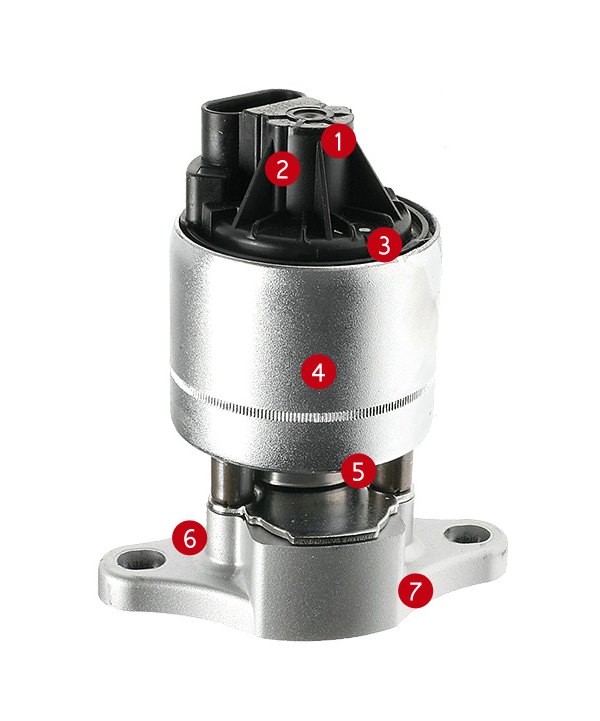
The EGR valve helps your vehicle burn fuel more efficiently and effectively by recirculating a portion of your exhaust and running it through the combustion process again. This results in a cooler, more complete burn of the fuel which decreases your vehicle’s noxious emissions by prohibiting the formation of some harmful gases.
Every Standard EGR valve is calibrated to OEM specifications for precision performance. The vacuum actuated EGR valves of the company are assembled with high-strength silicon diaphragms with steel reinforcement to extend the service life during operation. All Standard EGR valves must pass comprehensive quality testing including computer-controlled bench testing checks for resistance, leakage, and response as well as flow rates to ensure trouble-free operation before they leave Standard’s facility.
Features:
- Standard’s electronic EGR valves are made of palladium/gold/platinum alloy with a Teflon based lubricant to ensure very low contact resistance
- EGR valves are engineered for an extended service life
- Injection molded high temperature polymer prevents high temperature failure rate
- Stainless steel internal components and fully encapsulated copper windings and connections on electronic EGR valves ensure precision operation and greater protection
- EGR valves are designed as direct-fit OE replacements
- Improved anti-rust coating on the machine casting for additional protection against rust for maximum life
- Expected life is greater than 16 million cycles
- EGR Position & EGR Pressure Sensors
-
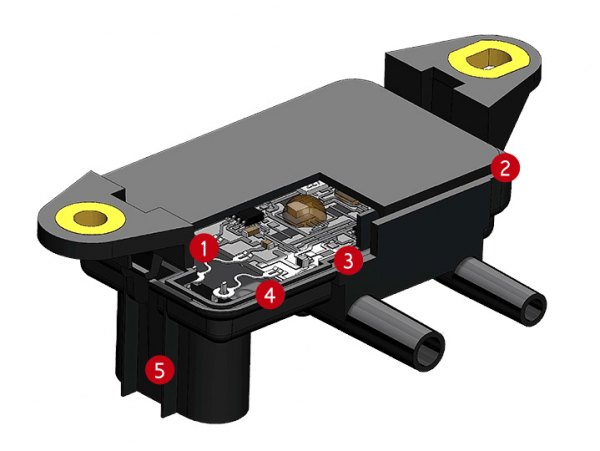
The EGR position sensor detects the movement and position of the EGR valve pintle. The EGR pressure sensor detects exhaust gas flow through the EGR passage. Standard EGR sensors use the finest components and every sensor must pass meticulous quality control to assure that each EGR sensor’s voltage output measurement will always be accurate. Each sensor undergoes a rigorous end-of-line test validating output voltages to exacting specifications for reliable, trouble-free operation.
Features:
- Utilizes custom BiCMOS IC technology, thin film laser trimming, and 2 sided ceramic circuit technology
- Manufactured in Standard’s TS 14001 and ISO/TS 16949 certified facility
- Component level EMI protection
- Sensors pass meticulous quality control to assure accurate voltage output
- Contains acid/gas resistant sensing element
Mechanical EGR valve position sensors are mounted on the top of the EGR valve while EGR pressure sensors will be located close to the EGR valve as the exhaust gas hose must be connected to the sensor and valve.
A malfunctioning EGR position or pressure sensor can illuminate the MIL, and may cause drivability problems. The signal is critical to the performance of the engine management system: too much flow - the engine will stall or have a rough idle; too little flow - emission gases (especially NOx) will be elevated and detonation will occur. Typical failure is due to opens, shorts, or intermittent signals.
A technician can use a scan tool to monitor the EGR position or EGR pressure data for changes during EGR operation and determine if these sensors are malfunctioning.
What makes Standard EGR sensors the best.
- Standard EGR sensors use the finest components including multiple precious metal contacts and polymer thick film resistors to provide extended service life
- Meticulous quality control and manufacturing processes assure that each EGR sensor’s voltage output measurement will always be accurate
- Each sensor undergoes a rigorous end-of-line test validating output voltages to exacting specifications for reliable, trouble-free operation
- Canister Vent Solenoid
-

The canister vent solenoid supports the Evaporative Emission Control (EVAP) System, which prevents gasoline vapors from escaping into the atmosphere from the fuel tank and fuel system. Standard canister vent solenoids are engineered with cutting-edge technology and premium components to offer superior protection from leaking and corrosion.
Features:
- Superior resistance to environmental influences due to proprietary one-piece molding technique
- Products are 100% tested in production
- High-temperature Viton O-rings to prevent leaking
- Manufactured in TS 14001 and ISO/TS 16949 certified facility
- PCV Valves
-

Standard offers both mechanical and electrical PCV (Positive Crankcase Ventilation) valves. Full-range mechanical PCV valves are manufactured in Standard’s Ocala, Florida facility. This highly specialized product location adds its own expertise and support to the Standard product line.
- Overview
-
As engine technology evolves, coil-on-plug technology will continue to play an increasingly important role in ignition systems. This product category will be at the forefront for years to come, and Standard is leading the way with an expansive selection of quality ignition components.
“The technology of the future, available for your engine today.”
- Ignition Coil-on-Plug (COP)
-

The ignition coil converts a low-voltage current to high-voltage energy that is delivered to the spark plug to ignite the air/fuel mixture within the cylinder. A coil-on-plug is designed to perform the functions of both the ignition coil which creates the spark energy, and the spark plug wire set that is designed to contain and deliver the high-voltage energy to the spark plug. Standard coil-on-plug assemblies are engineered and tested to meet or exceed OE standards for spark energy, impedance, and durability.
Features:
- Core has an internal neodymium permanent magnet surrounded by grain-oriented magnetic laminated steel - for maximum voltage output
- Tin-plated brass terminals
- Primary coil winding made of 200°C/392°F insulated premium 25-gauge copper wire - engineered and precision wound to generate a strong magnetic field for improved performance
- Secondary coil windings are precision wound and trimmed to produce desired output voltage
- Bobbin is made from polyphenylene oxide glass material to prevent voltage leaking between the primary and secondary coils
- High-temperature spark plug boot contains conductive stainless steel spring
- Housing constructed from high dielectric and impact resistant material that ensures long life in operating conditions
Ignition Coil Testing
Standard performed an extensive engineering analysis of OE DG500 and DG508. The engineers measured winding resistance, inductance and output voltage, spark, energy, waveform peak voltage and ringing, as well as a complete physical and sectioned comparison to OE.
The Findings
Standard ignition coils look, fit and perform like the original they replace with 100% end-of-the-line production testing. The Standard coils also provide an improved secondary winding design (additional winding bays) that helps prevent internal arcing and high-voltage breakdown.
- The Standard coils are tested 3.7% higher than OE in output voltage.
- The Standard coils were equal to OE in spark energy.
- In waveform testing, Standard coils’ peak output voltage was about 1000 Volts higher than OE.
- The Standard coils had a longer spark duration than the OE, resulting in more energy supplied to the spark plugs.
The Standard coils match or exceed the OE coils in all categories and are an excellent replacement exceeding the OE performance.

- Ignition Coils (Water Intrusion and Premature Coil Failure)
-

UF303 - Coils and Water Don’t Mix!
On some GM models (4.2 inline 6 cyl. LL8 VIN code S – PRO LL8), water intrusion will cause premature failure of the coil and spark plugs — it’s not a coil problem!
Signs of Premature Failure
If a customer complains of a rough idle and/or the MIL/SES light flashes on after a rain shower or car wash, this may indicate water intrusion.
Check for possible DTC codes P0300 through P0306 and inspect the coils and spark plugs. If upon inspection of the coils, a white chalk-like build-up on the inside and/or outside of the spark plug boots is detected, the coils have been damaged and must be replaced with Standard hi-quality UF303 coils. It is also advised to replace the spark plugs.
The Remedy
Water can seep past the engine cam cover and collect below the coils in the spark plug wells of the cylinder head resulting in a possible misfire. To prevent this condition from reoccurring, the AIP seal must be replaced with a replacement seal that redirects the water away from the engine cam cover.
- Ignition Modules
-

- TechSmart distributor assemblies
-
TechSmart engineers have developed the finest quality, OE matching distributor assemblies for GM 4.3L V6 & 5.0/5.7L V8 applications. Behind each part is a meticulous attention to detail, rigorous testing, and over 90 years of experience in ignition manufacturing.
Features:
- High dielectric strength cap ensures accurate energy transfer and spark timing
- Improved gear design for enhanced performance in high-torque applications
- Stainless steel screws protect against corrosion
- 100% tested to ensure peak performance and extended distributor life
- SAE J1171 certified for use in marine applications
- Manufactured in SMP Greenville, SC facility

- Overview
-
Standard is your go-to source for a full line of accessory and electronic relay solutions that support all key engine components and systems, including: daytime running light kits, blower motor resistors (two or four), and TechSmart HID ballasts.
“Standard Technology. The excellence is in the details.”
- Daytime Running Light Kits
-
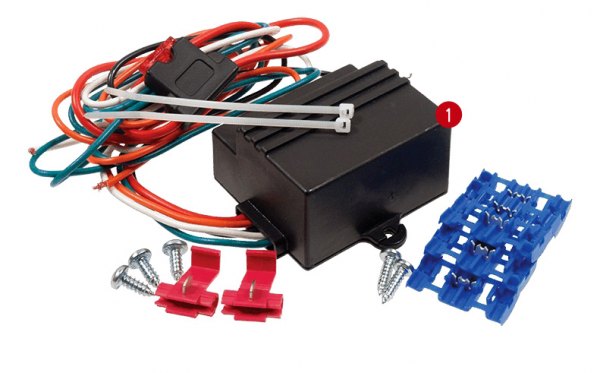
Standard daytime running lights are 100% tested to verify both mechanical and electrical switching performance. Standard switches are designed using copper alloy conductors to ensure superior electrical conductivity with low resistive losses.
- Blower Motor Resistors
-

Standard offers full line coverage for domestic blower motor resistors including the proper replacements for the Chevy/GMC truck problem-applications. With more than 200 blower motor resistors in the line, you can count on Standard for the right resistor, always matching the original fit, form, and function.
Features:
- Reliable OE design for precise fit, form, and function every time
- Use heavy molded ceramic body for maximum heat dissipation
- Nichrome wire winding for robust durability and extended life
- TechSmart HID ballasts
-

TechSmart delivers high-quality, direct-replacement HID headlight ballasts for domestic and import vehicles. HID headlights require a ballast to power them since they do not run on low-voltage current. When a ballast overheats and fails, the HID light system becomes inoperative. TechSmart’s line of HID headlight ballasts covers today’s most popular domestic and import applications. A high attention to quality ensures that this advanced safety feature functions properly each and every time you install a new TechSmart unit.
- Overview
-
Standard is your source for the very best in wire technology, with total coverage. You’ll enjoy effortless installations plus cutting-edge technology that delivers superior power and efficient performance. For the fit, form, and function you demand, Standard is your complete wire set resource. Using advanced technology from the inside out, Standard engineers its ignition wire and cable products to outlast and outperform the competition.
- Standard OE Plus Performance Professional Wire
-
Standard OE Plus Performance professional wire sets feature original equipment fit, form and function. Every set is designed, built and tested to meet or exceed OE quality standards. Standard wire sets feature “better than OE” D.I.S. coil boots and OHC boots that provide better dielectric performance than OE plastic tubes. Its wire sets contain heat shields, looms, and high-temperature silicone boots, where required, to provide advanced protection from the harsh conditions of the engine.

- OE style magnetic suppression silicone cores provide protection from premature burnout and conductor damage failures
- Correct resistance values promote hotter spark intensity and longer spark duration for maximum performance and fuel economy
- High-grade silicone insulation protects against core voltage leaks to ensure long service life
- Fiberglass reinforcement provides strength flexibility
- Silicone jacket provides thermal protection from extreme underhood temperatures and resists petroleum-based contaminants for long service life
- Corrosion-resistant snap-lock and ABITS terminals provide a positive connection therefore easing installation for hard-to-reach cylinder locations

Proper installation angles?
Boots configured at proper installation angles resist extreme engine heat and petroleum based contaminants.
"Better than OE" D.I.S. coil boots?
A Standard exclusive - extra thick molded boots seal the inside and outside of the coil tower, locking voltage in and moisture out.
Problem solving OHC boots?
Provide better dielectric performance than plastic tubes.
Heat shield and loom?
Provides advanced protection against abrasion and high heat on select applications.
Triple silicone wire?
- Combines the conductor, insulation, and jacket materials for unsurpassed thermal protection.
- Certain late model applications will have magnetic suppression (MAG) core for enhanced performance.
High-temperature silicone boots?
Specially made to withstand extreme heat.
- Standard Coil-on-Plug Boots
-

Coil-on-Plug systems are designed to distribute the ignition spark more efficiently to the fuel in the combustion chamber. Coil-on-Plug delivers between 30 and 60 thousand volts directly to the spark plug thousands of times per minute. The connection between coil and spark plug is made through the Coil-on-Plug boot. Standard coil-on-plug boots are made up of a flexible, heat-resistant outer cover over a conductive spring that delivers the spark from coil to spark plug.
Engine environment, heat, water contamination, fuel and lubricant contamination and abrasion damage can all shorten the life of Coil-on-Plug boots significantly and may require replacement to keep an engine running efficiently. Standard coil-on-plug boots are manufactured from the best materials for top performance and endurance – so next time you replace the engine’s spark plugs, replace the coil-on-plug boots with Standard.
Features:
- Engineered to the specifications used by the original vehicle manufacturer for exacting fit
- High-temperature material provides greater protection from thermal overload
- Tight weatherproof boot seal protects against moisture intrusion
- Stainless steel internal spring with resistor to suppress RFI and deliver maximum voltage to the plug
- Standard Coil-on-Plug Boots/Wire Set Kits
-

Some of the newer engines are designed using both wire leads and direct coil-on-plug boots. Standard offers a complementary line of ignition coil-on-plug boot /wire set kits. Complete tune-up kit includes custom fit wire set and coil-on-plug boots - everything you need in a single package to complete the job. All of the components are manufactured to the specifications required for your vehicle and are equivalent in fit, form, and function to the original so you can install with confidence.
Features:
- Wire leads have specially formulated jacket materials to resist heat and chemicals for extra protection
- Wire has superior RFI suppression for cellular phone communications and vehicle electronic systems
- Superior dielectric strength combine with high-temperature materials for extra protection and durability and a long service life
- Tight weatherproof boot seal protects against moisture intrusion
- Stainless steel internal spring with resistor to suppress RFI and deliver maximum voltage to the plug
- High-temperature material provides greater protection from thermal overload
- About
-
TPMS innovation from Standard
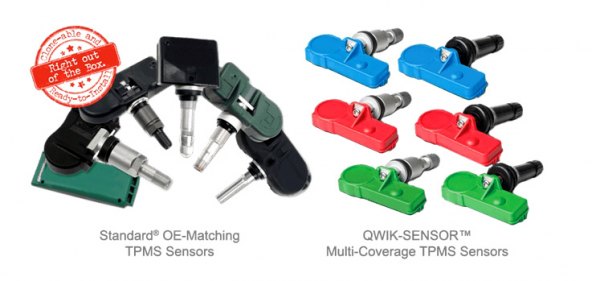
One TPMS Supplier. One complete TPMS program. Real clarity.
You know that Standard and Intermotor offer a complete TPMS line featuring OE-matching direct-fit cloneable TPMS sensors, mounting hardware, service kits, shop tools and more than 98% coverage. And that means technicians get the best of both worlds – an OE-matching TPMS sensor with advanced technology built in to make it ID cloneable, saving time and money in the bay. But did you know that these same Standard and Intermotor OE-matching cloneable TPMS sensors can be OE-relearned, work with all major TPMS service tools, and are ready-to-install right out of the box.
And that’s not all. Standard now offers the most advanced multi-coverage (multi-fit, multi-application, universal) TPMS sensor in the market today – NEW QWIK-SENSOR™!
Innovative QWIK-SENSOR™ line covers 94% of all domestic, European and Asian applications with only 3 multi-coverage TPMS sensors. They are easily programmed with the TechSmart T55003 TPMS tool and once activated can be ID-cloned or OE-relearned, at technician’s choice. Each QWIK-SENSOR™ is available in two valve stem configurations, metal or rubber to match the proper application. QWIK-SENSOR™ TPMS sensors are color coded for easy identification and come fully assembled right out of the box.
Discover Standard TPMS features and benefits for yourself

Testing and product validation
Environmental testing using SAEJ2657 certification standards
- On-vehicle live test for 168+ hours
- Operational temperature test
- Thermal shock test
- Extreme temperature test
- Humidity test
- Frost test
- Proof pressure test
- Rapid deflation test
- Contamination test
- Salt fog test
- Drop test
- Vehicle speed test (centrifugal force)
- Mechanical vibration test
- Intro to TPMS
-

In a recent study, 42% of drivers were unable to identify the TPMS symbol.
In this study, 4 out of 10 drivers could not identify the TPMS warning light, even though 96% of drivers considered under-inflated tires an important safety concern and 89% believed that properly inflated tires and a warning system could save their lives.
This is your TPMS (Tire Pressure Monitoring System) warning light and when illuminated, it indicates that the tire pressure monitoring system has found a tire with low air pressure, a sensor with a dead battery or a TPMS system malfunction.
The Tire Pressure Monitoring System is a safety device that measures, identifies and warns you when one or more of your tires are significantly under-inflated. The TPMS light on your dash will flash if there is a system malfunction, while a steady illuminated light indicates an air pressure problem.
If the TPMS light is illuminated, the first order of business is to check your tire pressure. If driving, pull over safely at the first opportunity. Once you determine you are not having a blowout, check the pressure in each tire with a tire gauge. If the problem is low tire pressure, fill your tires to the recommended pressure noted on your placard. Once corrected, most vehicles will reset the TPMS light automatically, some will require a manual reset and some may require professional attention (refer to the owner’s manual). If your TPMS light is still illuminated after correcting the air pressure or you notice any tire damage, see a professional technician immediately.
Some vehicles may feature a different TPMS display but regardless of the type of TPMS alert in your vehicle, if it’s illuminated, your vehicle is trying to tell you something. One or more of your tires is underinflated or the TPMS system itself is malfunctioning and it needs immediate attention from you or your service professional.
Ignore your TPMS light and you may experience one or more of the following:
- Poor fuel efficiency
- Compromised vehicle handling
- Increased risk of hydroplaning
- Diminished braking performance
- Shorter tire life
Did you know?
- 35% of drivers admit to never checking tire pressure.
- There’s a flat tire for every 46,000 miles driven.
- Three out of four roadside flats are preceded by a slow leak or under inflation.
- Low tire pressure is responsible for nearly ¼ million accidents annually.
- An SUV owner can save up to $600 a year just by keeping the tires properly inflated.
- Under-inflated tires waste 2.8 billion gallons of gas annually in the US at a cost of $11.2 billion.
- NHTSA estimates that TPMS could save as many as 660 lives annually.
- It is a violation of federal law to render a TPMS system inoperative.
- The TPMS sensor is typically located as a valve-mounted stem in the tire. There are also band-mounted sensors that are attached to the wheels themselves.
- TPMS sensors can fail due to road hazard damage, over-tightening, using an improper valve core, electronic failure or sensor battery discharge.
- Virtually every original sensor will need to be replaced.
- The TPMS warning light illuminates when one or more tires become 25% under-inflated. This can lead to decreased vehicle handling, risk of hydroplaning, diminished braking performance, uneven tire wear and shortened tire life.
- The TPMS warning light will illuminate if there is a problem. A professional technician can test TPMS sensor operation.
Ask your technician to check your TPMS every time your tires are serviced
When it’s time to replace your TPMS sensors, there’s no need to go back to the dealer. Ask your trusted service technician for Standard and Intermotor cloneable TPMS sensors. Advanced cloneable technology ensures a perfect match, with designs that meet or exceed the quality and performance of your vehicle’s original equipment. Plus, a faster and easier installation with no “relearn time” will get you back on the road in record time.

TPM Wireless Technology
TPMS Sensors communicate wirelessly with the vehicle
- Transmits “protocol” specific to the vehicle
- Transmits unique ID - a sensor serial number identifying tire and location to the vehicle
Sensor replacement
- New sensor must have matching protocol to OE sensor
- Vehicle needs to learn each new sensor’s ID
Traditional installation requires “relearn process”
Standard OE-matching sensors can be installed right out of the box and OE-relearned or can be ID-cloned eliminating the need for the OE-relearn process
- OE-Matching Sensors
-
Ready-to-install right out of the box
Standard and Intermotor OE-matching cloneable TPMS program
Standard and Intermotor offer a complete TPMS line featuring OE-matching direct-fit cloneable TPMS sensors, mounting hardware, service kits, shop tools and more than 98% coverage. This is the best TPMS coverage featuring the most advanced TPMS sensors.
Standard TPMS sensors are specifically engineered to match the fit, form and function of the vehicle’s original sensor. Each OE-matching cloneable sensor has its own unique sensor ID, the right protocol and matching body style. And with sophisticated technology built in to make it ID cloneable, Standard OE-matching sensors allow technicians to bypass complex OE relearn procedures. Techs get the best of both worlds – a matching sensor with built-in time-saving technology.
But that’s not all. These same Standard and Intermotor OE-matching cloneable TPMS sensors can be OE-relearned, work with all major TPMS service tools, and are ready-to-install right out of the box. That’s right, Standard and Intermotor advanced OE-matching TPMS sensors can be ID-cloned or OE-relearned; at technician’s choice.
Standard OE-matching cloneable TPMS sensor line

- TPMS from the leader in vehicle sensor technology – full design, manufacture, marketing, sales, and technical support
- Standard OE-matching cloneable TPMS sensors were a New Product Showcase Winner at AAPEX 2012
- Full program includes TPMS sensors, service kits, accessories, mounting hardware, and the right TPMS tools
- Standard sensors are direct-fit and OE-matching
- Advanced ID “Cloning” technology
- Ready-to-install right out of the box
- 187 total part numbers including a broad service line of compatible valve cores, valve nuts, seals, washers and valve caps
- 122 total OE-matching TPMS sensors with more than 98% coverage for domestic and import vehicles
- 62 Cloneable sensors with 85% coverage for domestic and import vehicles
- 24 out of the top 25 OE-matching sensors are cloneable
- Cloneable sensors look, fit and function like the OE
- Each sensor comes with its own unique sensor ID and uses the exact OE protocol to ensure reliable performance
- Technicians can bypass complex OE relearn processes, clone the sensor ID – saving time and money while maintaining OE fit, form and function
- Cloneable sensors can be ID-cloned manually with the TechSmart T55000 tool or using RF transmission with T55001 and T55003 tools
- Engineered to match OE fit, form and function, Standard sensors are also ready-to-install right out of the box and can be OE-relearned
- Standard cloneable sensors can be used with all OE and aftermarket TPMS programming tools
- Standard TPMS sensors are designed to operate within an extremely tight radio frequency (RF) eliminating most external interference for a more accurate monitoring of the tires
The Standard OE-matching cloning process

Step 1: Locate the ID number on the old sensor. (*If old sensor is destroyed, the ID number may be retrieved from the vehicle’s computer.)
Step 2: Place the new Standard cloneable sensor in the holding tray of the TechSmart T55000.
Step 3: Enter the ID Number from the old sensor and press enter.
Cloning is now complete! It really is that easy!
Step 4: Write the cloned ID on the sticker provided with the new Standard sensor.
Step 5: Affix sticker to back of the new sensor.
Don't forget the service kit
TPMS service parts should be replaced every time a tire is removed from the wheel. These parts may include valve stem, seal, washer, nut, valve core and cap.

- QWIK-SENSOR™
-
Introducing QWIK-SENSOR™
QWIK-SENSOR™ is an innovative multi-coverage TPMS sensor program featuring ease of programming, advanced technology and complete coverage.
The QWIK-SENSOR™ line includes 3 sensors in both metal (M suffix) and rubber (R suffix) factory-installed valve configurations*;
TPMS service kits, replacement valves, mounting hardware and the right TPMS shop tools.
QWIK-SENSOR™ is complemented by a complete Standard and Intermotor ‘OE-matching cloneable ready-to-install right out the box’ program.
3 Color-coded sensors provide 94% coverage

Discover for yourself the QWIK-SENSOR™ advantage
- 3 sensors provide 94% coverage
- Available in two valve stem configurations, rubber or metal, to match the proper application
- All QWIK-SENSOR™ sensors come fully assembled from the factory, ready to install when activated – with no valve changes required
- Color-coded for easy identification and programmed with TechSmart tools
- ID cloneable or can be OE-relearned
- Works with all major TPMS tools
Programming is easy with the TechSmart T55003 TPMS tool kit

- Full-function Gen II TPMS activation and programming tool with cloning and full factory relearn capabilities. OBDII function removed to create a powerful mid-level shop tool.
- Programs new QWIK-SENSOR multi-coverage TPMS sensors and performs many other TPMS functions.
- T55003 will ID-clone QWIK-SENSOR as well as Standard OE-matching cloneable sensors and will also follow the OE factory-relearn process.
It really is 'QWIK'

- TPMS Tools
-
When it’s time to replace your TPMS sensors, there’s no need to go back to the dealer. As a leader in TPMS technology, Standard and Intermotor provide the best TPMS coverage in the industry. In addition to full line of perfect-match TPMS sensors, designed to meet or exceed the quality performance of the vehicle’s original equipment, Standard also offers a complete line of tools for service technicians. TPMS sensors can be installed faster and easier, all to get vehicles back on the road in no time.
T55001: TechSmart TPMS relearn and scan tool kit

The Techsmart T55001 TPMS relearn and scan tool performs the relearn process on all import and domestic vehicles and displays complete sensor information including: tire pressure, tire temperature, broadcast frequency, battery status, sensor ID and tire location.
- Performs TPMS sensor relearn process on all import and domestic vehicles
- Displays complete sensor information including: tire pressure, tire temperature, broadcast frequency, battery status, sensor ID and tire location
- Includes trigger magnet for activating sensors that require magnetic wake-up
- Easily updatable through a USB-equipped PC with internet access or by micro SD card option
- Reads and displays TPMS Diagnostic Trouble Codes (DTC) for Asian vehicles
- Clones the original sensor by transferring the ID number (electronically or manually) onto the cloneable sensor
- Detects radio frequency interference
- Tests key fobs
- OBDII capabilities
T55003: TechSmart TPMS tool kit

Programming QWIK-SENSOR™ is simple with the TechSmart T55003. In a few simple steps, the technician can load the correct protocol on to the QWIK-SENSOR™ multi-coverage sensor. Once the protocol is loaded, the ID of the failed unit can be ID cloned on to the sensor in under a minute.
- Full-function Gen II TPMS activation and programming tool with cloning and full factory relearn capabilities.
- OBDII function removed to create a powerful mid-level shop tool with expensive features to diagnose tire pressure problems.
- Programs new QWIK-SENSOR™ multi-coverage TPMS sensors and performs many other TPMS functions.
- T55003 will ID-clone QWIK-SENSOR™ as well as Standard OE-matching cloneable sensors and will also follow the OE factory-relearn process.
- Scan, trigger, activate, and clone ID tool all in one.
- Programs new QWIK-SENSOR™ multi-coverage TPMS sensors and performs many other TPMS related functions.
- Easily ID clones QWIK-SENSORS and Standard OE-matching cloneable sensors and is capable of following the OE-factory relearn process as well – at tech’s choice.
- Scan/trigger all OE and aftermarket sensors.
- Software provides comprehensive coverage of 2013 vehicles and prior, large LCD screen is easy to read and 3X larger than other tools on the market. Display sensor functionality, tire pressure, battery life, and sensor ID on one screen.
- Menu includes make, model, year and programming. Ensures the correct frequency to eliminate cross talk.
- Large keypad makes it easy to select and input.
- Rechargeable battery and charger included.
T55000: TechSmart cloning tool

Developed to be used with Standard and Intermotor cloneable sensors, the TechSmart T55000 cloning tool enables service technicians to clone the ID of the existing sensor to the new cloneable sensor.
- Fast and easy-to-use
- Works with all cloneable TPMS sensors
- No relearn needed
Installation is as easy as 1, 2, 3.
TPM5010: TPMS service tool kit

This high-quality TPMS service tool kit contains all the tools necessary to manage your TPMS service.
- 1/4” Torque wrench 30-150 in/lbs
- 1/4” tool complete with 11mm and 12mm deep sockets offers a wider torque range which helps ensure accurate TPMS nut installation. Also includes 1/4” T20 torx socket, preset at 35 in/lbs for European valve screw applications
- 1/4” Torque screwdriver
- 1/4” Torque screwdriver is preset to 12 in/lbs for use when replacing rubber snap-in valve stems for various TPMS sensors. Includes 4 x T10 Torx bits and 2” extension
- Valve core torque tool
- Reduce come backs with this calibrated precision tool (4 in/lbs) for TRA recommended torque specifications on TR C1 valve cores, including nickelplated cores. Serves as both a valve core remover and installer
- Rugged Tool Case
- Complete kit also includes thumb valve core installation and bleeder tool, grommet pick, and grommet removal
How involved is the OE relearn process?

Typical relearn processes
Chrysler relearn
Typical Chrysler Relearn - Considered an “Easy” Relearn Process
- Must write ID number down before installation (If sensor is installed before retrieving new ID number, then technician would need to break down the tire to retrieve the number)
- Plug in scan tool to OBDII port on car
- Build vehicle specifications in the tool
- Go to TPMS relearn function in tool
- Enter new TPMS ID numbers in tool
- Must be entered one at a time
- Exit out of tool
- Install TPMS sensors
- Drive vehicle – Up to 45 minutes
Lexus/Toyota relearn
- Need TPMS tool to read all ID numbers off old sensors (1.Once learning is initiated, it will wipe all ID numbers (TSB L-SB-0025-09) 2. If technician fails to get the ID numbers at the start – he will need to break down all four tires to get number off sensor (1-1/2 hours)
- Need factory scan tool to initialize reprogramming procedure
- Plug factory scan tool into OBDII port on vehicle
- Initialize learning procedure
- Learning procedure takes approximately 15 different steps (Technician interaction on a pc)
- Vehicle is reprogrammed and ready to drive
- Approximate time with no issues 1/2 - 1 hour
OE Auto-learn process
- Install sensor in vehicle (no ID number required)
- Drive vehicle 15-45 minutes until light resets
- During driving, the system will learn the new sensor ID (If the vehicle has been stationary for more than 20 minutes, the vehicle must be driven for a minimum of 10 minutes and maintain a continuous speed above 15 mph)
- The problem is that it doesn’t always work
- Relearn will not always initialize on its own
- TechSmart Electronic Throttle Bodies
-
Standard found out that technicians needed a cost-effective solution for repairing failed electronic throttle bodies. TechSmart responded with a complete solution for replacing these expensive OE units. TechSmart has a complete line of ‘100% new, not-remanufactured’, high-quality direct replacements for failed units. No comebacks due to worn units in a partial rebuild. TechSmart offers more than 50 OE-matching electronic throttle bodies covering more than 30 million Chrysler, Ford, GM, Infiniti, and Nissan vehicles and they’re all new, not remanufactured.

- MAF (Mass Air Flow) Sensors
-

The Mass Air Flow (MAF) sensor measures the amount of air flow entering the intake manifold using a heated grid or wire. The PCM uses this signal primarily for fuel control. A failing sensor can illuminate the MIL, and may cause the engine to run rich or lean; the engine may lack power and produce “pinging” noises during part throttle driving.
Features:
- Common component failures are 100% replaced
- Upgraded components are used to improve circuit reliability and performance
- 100% computerized testing for all sensors using advanced test equipment
- Use OE specifications to ensure accurate readings and airflow output
